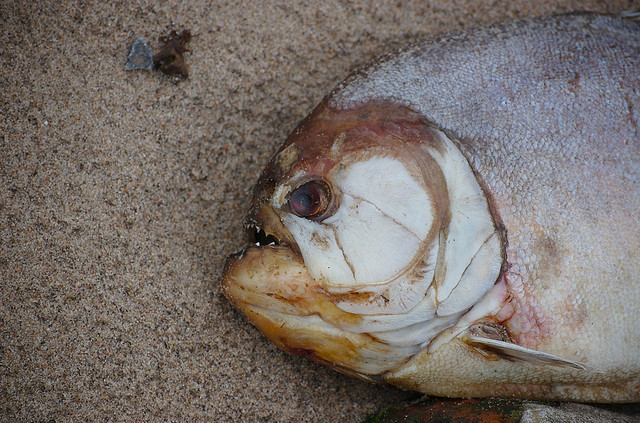
There is nothing pretty about the fish being imported into the US -- and that's 80 per cent of the fish we eat. (Photo by Beatrice Murch/Flickr)
Globalized industrial fish factories are flooding the markets of the world with dangerously tainted fish laced with toxins and carcinogens banned by law from US food. They are doing this to replace the fish once supplied by industrial fishing fleets that have virtually destroyed the world’s stocks of wild fish; 80 per cent of the fish consumed in the United States is imported, and half the imported fish comes from fish factories. The tainted fish continues to come in despite ineffective efforts by state and national governments to stop the flow — efforts that, weak as they always were, are now being eviscerated by state and federal budget cuts. The fish factories, meanwhile, are making lots of money.
The problems with industrial fish factories (to call them “farms,” as the industry prefers, is to acquiesce to the continuing mutilation of language and meaning) are the same as those that arise in industrial cattle, hog or chicken plants: Close confinement and forced feeding of unnatural diets leads to stress, sickness and high concentrations of manure. To keep animals alive until they reach market weight, industrialists dose them heavily with antibiotics and anti-parasitics, substances whose residues in the treated animals’ flesh can sicken its consumers.
US law sets strict limits on these residues, but US law enforcement has very few cops on the beat. A study by the Government Accountability Office released three months ago warned that the methods used by the Food and Drug Administration to ensure the safety of imported fish are woefully inadequate. The GAO did not say that, of course, it used the term “limited” many times, and occasionally “ineffective.” Bottom line: the FDA actually tests less than one-tenth of one per cent of seafood imports for drug residues.
FDA spokesperson Douglas Karas called that “targeted, risk-based testing of products,” not a hopelessly inadequate response to the threat. His agency, he said proudly, “inspects foreign processing facilities and consults with foreign authorities,” but the GAO investigation revealed that the inspections are of the facilities’ books, and do not involve actual visits to the fish factories, while the consultation consists of cursory reviews of what foreign governments say they intend to do to regulate fish factories.
Despite not trying, the Feds occasionally, accidentally hook a culprit. Three American fish importers pleaded guilty in federal court to felonies involving the importing of six tons of fish into Mobile, Alabama and Seattle, Washington that was contaminated with an antibiotic and a substance called malachite green, a suspected human carcinogen that is used to control external parasites that attack crowded, confined fish.
Three importers down. But according to the watchdog publication Fair Warning, state government dissatisfied with the lackadaisical federal efforts that have looked into the state of imported fish for themselves haven been horrified by their findings:
- Alabama finds that 40 per cent of the imported fish it tests contain dangerous levels of banned substances.
- Tennessee found prohibited antibiotics at dangerous levels in imported basa fish, a type of catfish raised in Vietnam.
- Arkansas found crystal violet — an antifungal and anti-bacterial compound that is readily absorbed by fish tissue and a carcinogen in human tissue — in catfish.
- Florida found 19 per cent of catfish tested had unsafe antibiotic residues.
- Georgia also detected such residues in catfish.
Most states do not test their imported seafood, they rely instead on the FDA. See above.
What’s the remedy for this? First, forget government. The demand is too great, the industry too wealthy, the government too weak, and any effort to change things will be filleted immediately by lobbyists. But as I explained in Brace for Impact: Surviving the Crash of the Industrial Age by Sustainable Living, while it is impossibly difficult, now, to protect everyone, it is a simple matter to protect anyone.
Do not eat imported fish: first because it is obviously unsafe, and second because the dollars you spend on it are votes to continue the system as it is. We need to starve that beast.
Eat wild fish caught in safe waters, or farmed fish raised by someone you know whose farm you can visit any time you want to. Don’t bother to tell me that everyone can’t do that; I stipulated that we can’t protect everyone. And don’t bother to plead that it’s too much trouble. I said it was simple, not easy, and the trouble involved is nothing compared to the trouble that’s coming.
Observe the same rules for all you food and you can be relatively safe and relatively well nourished as long as the current system lasts. True food security can be found only in growing your own.
-0-
For details of the GAO study of FDA oversight of seafood imports, click here.
For details of the Fair Warning followup study, go here.
For much more about the state of your food supply, go here.